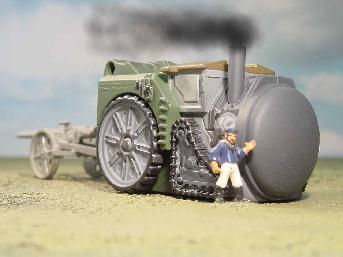
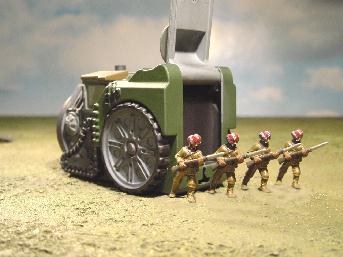
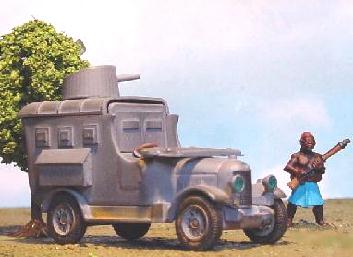
Fowler, as leading manufacturer, could not stay behind in the race and designed an armoured steam tractor. To reduce the wheel-base as much as possible, the boiler ended up being a very compact affair with a hugh diameter indeed. The otherwise useless space between the big aft wheels was transformed into an armoured compartment with room for 8 fully packed soldiers. At the back of the tractor was a (steam operated) hinged door to fast unload the troops. The armament consisted of a single machinegun on top of the cockpit. During trials, the small front wheels proved inadequate and were substituted by the Adolphe Kegresse track system, much improving the (otherwise very poor) terrain performance of the vehicle. The tractor was designed to haul heavy artillery or coal & wood tenders for the hungry steam powered landships, but could double as a (slow) APC. The vehicle was nicknamed "Pig" by the British and "Sau" by the Germans. Built by the Afriborian Steamtank & Landship company - A.S.L.)
(Mc Donalds "Atlantis" Happy Meal conversion).
ON DAF-CHASSIS, AS USED BY THE ARMIES OF THE "SUID-KOLONIE".
The "Type A" was the first attempt to convert the small DAF-truck into an armoured car. An armoured box was placed behind the driver's compartment with 3 fire-ports on each side. The main doors were at the back and behind the driver there were two smaller doors to permit the crew to take refuge in the armoured box. All doors had fireports. The (armour-plated) windscreen could be folded down to improve vision. The vehicle was topped by a turret with a Hotchkiss machinegun.
(25/28 mm Oxford Diecast conversion).
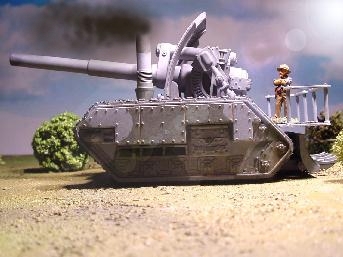
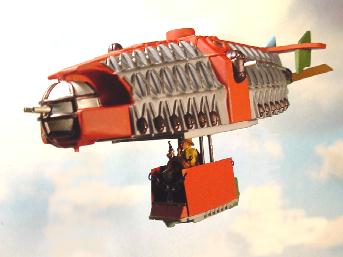
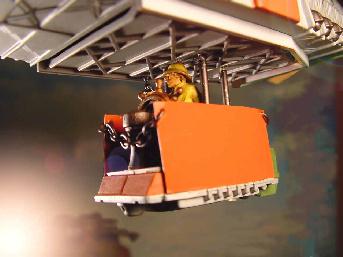
"
HMLS UNSINKABLE ", MIGHTY BRITISH
STEAM-POWERED LAND-MONITOR.
Only
a few of these land-borne battleships have been launched by the British,
who want to rule the land as well as the waves. HMLS UNSINKABLE
is armed with a single massive 12" gun with a protective shield.
"HMLS
UNSINKABLE" is a fully tracked steam-powered monster. The gun
can - of course - only be fired when the landship is stationary. Land-monitors
are designed for besieging towns and fortifications and not for regular
battles. Built by A.S.L.
/28 mm Games Workshop conversion).
German "Punktlichkeit" (punctuality) was a big issue with the "Postverwaltung" (German Post Office). Mail had to be delivered as fast as possible across the vast German Empire. Therefor the post-office commissioned the airship constructor Zeppelin and the aircraft manufacturer Messerschmidt to design and build the "Zepperschmidt": a compact flying machine, part airship, part plane. in fact this was the very first VTOL. Since the military were also interested, a twin machinegun turret (in unbreakable mirrorglass & aluminium) was added to the nose section as well as a machinegun amidships on each side of the Zepperschmidt, thus creating a powerful bomber-gunship, performing much like a modern helicopter. The craft had a crew of four: one turret-gunner, two side-gunners/engineers and one commander/helmsman. Communication was by an early form of intercom. Although the ship looked massive and sturdy, the materials used were - apart from the engine - almost exclusively canvas, glass and aluminium. When flying low it proved to be vunerable even to small arms fire, but from a certain altitude and without other aircraft or AA-guns near, it could strafe the enemy unpunished.
(Mc Donalds "Atlantis" Happy Meal conversion).
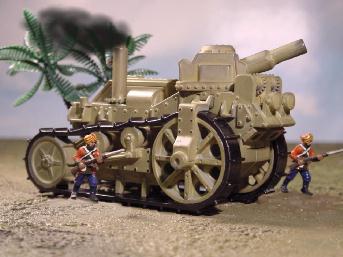
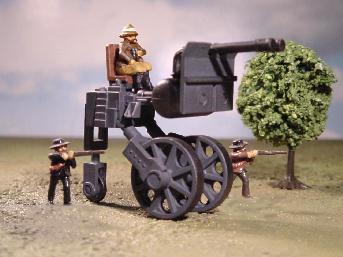
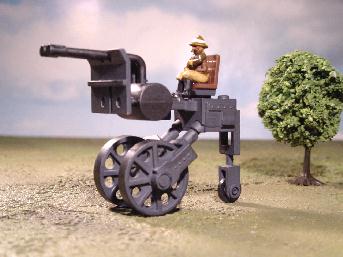
When Belgium entered the race for Afriboria, King Franz II of Belgium himself ORDERED the A.S.L. to provide his expeditionary forces with some muscle. One of the most powerful results was the "Rhino" steam tank. Much smaller and lighter than most other steam propulsed warmachines, this tank proved to be very efficient indeed. Armed with a fine short-barreled gun-howitser in the turret, its steam-engine positioned at the back and with a streamline other steam-powered vehicles could not even come near to, the "Rhino" was a reliable fighting machine loved by the troops. It served as an example for more recent petrol-engined tank design.
(Disney "Atlantis" toy conversion).
"
BUSH BURNER Mk 2 ".
The
American agricultural machinery manufacturer BUSH created the "Bush
Burner", a tall contraption on three wheels intented to burn down
fields en bushes in an industrialised fashion. Some of these machines
were shipped to the Suid-Kolonie to help create new farmland. During
a Zulu-raid on a group of Boers, a "Bush Burner" was at hand
and the driver desperately aimed it's fire at the charging impi, killing
many Zulu warriors and routing & demoralising the rest, thus saving
his companions from a certain death. From that time onwards the "Bush
Burner" was used on many occasions as a flame-throwing weapon by
army and militia alike. The boost in sales and prestige that followed
made the Bush-family very influential people. The family entered politics
and reached the highest level. The "Bush Burner" Mk 1 had
a petrol-engine with two vertical exhaust pipes at the back, whereas
rechargeable batteries formed the power source of the Mk 2. The maximum
speed of this machine - due to it's design - was 4 miles/h (6 km/h);
a good thing because without the cover of infantry it made an easy target
to surround and destroy.
(Disney "Atlantis" toy conversion).
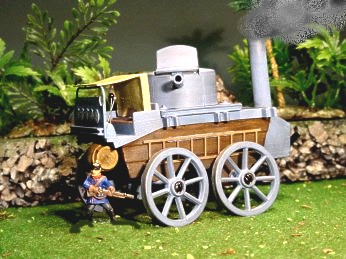
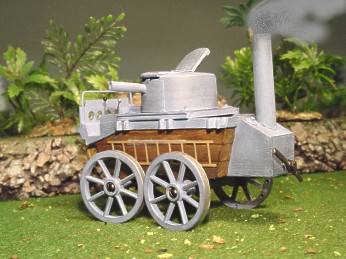
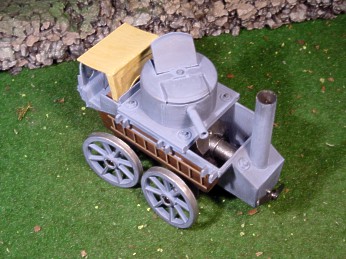
"
PanzerDampfwagen VII - LÖWE " (PzDw VII Amf) by the A.S.L.
Since the German Empire was
known for innovation in design, their new wooden steam wagon may have
looked outdated when introduced, but in fact it was very much ahead of
its time. It was specifically designed for operations in Afriboria. The
wooden hull was not only lighter than steel or iron, but was bolted together
so it could easily be taken apart to be transported aboard river craft.
The mechanical components were kept as basic as possible (as was the steam
engine) to simplify repairs in the field. For the same reason wheels were
used instead of tracks. The pontoonshaped watertight wooden hull (with
metal lining) made the vehicle amphibious (note the aft propeller - steering
in water was by means of the forward wheels, acting as rudders). In combat,
the tarpaulin protecting the cockpit had to be removed to enable the gun
to fire forward. The cockpit could accomodate both driver and guncrew.
(western cowboy wagon toy conversion - figure for scale reference is
a 28 mm West Wind).